
|
Jarmila Kaczmarek
(Poznań Archaeological Museum)
Megalomania and expansionism.
On Polish-German relations within archaeology
in the Wielkopolska region
|
During
the past few years, the supporters of Slavic allochtonism theory
have been discussing with the followers of Slavic autochtonism.
The allochtonists claim that Józef Kostrzewski developed the theory
of Slavic neoautochtonism east of the Odra River in order to balance
German autochtonism, the theory developed by Gustav Kossina. Józef
Kostrzewski, Kossina's disciple, based his ideas on political
reasons and on "sheer spite" - in order to oppose German expansionism
by means of the Polish one. This conviction seems to be popular
among archeologists from the former Russian and Austrian partition
of Poland, for whom the experiences of the inhabitants of the
former Prussian partition seem quite incomprehensible.
Before I present Poznań
records and rare publications which constitute the source for
this presentation, I wish to recall the definition of expansionism.
This term covers the intention of a state to expand its territory.
When a conflict relates to a part of a given country, we can only
talk about national, religious and social conflicts based on i.e
unequal treatment of a group of citizens by the government, nationalism
or megalomania.
Mieszko, a Polan prince
of Wielkopolska received baptism in 966 AD, thus introducing his
country to the culture of Christianity and, via west European
clergymen of Latin order, his territory was accepted on the arena
of west European culture and antique traditions. As early as in
the 13th century, a Polish bishop from Krakow, Wincenty Kadłubek,
in his "Chronicles of Poland" tried to combine the history of
Poland with ancient history which was so close to his heart. According
to him, Gaelic Lechistan people, who fought successful battles
against the army of Alexander the Great and Julius Caesar, were
the ancestors of contemporary Poles. Kadłubek axiomatically assumed
that Poles settled on the territory marked by the Vistula and
Odra Rivers and the Baltic Sea several hundred years BC at least.
This "Gaelic link" made it very clear that Kadłubek was convinced
of the autochtonism of ancient Poles, even though they seemed
to be present in source materials under a different name. This
direction determined by Kadłubek was later followed by numerous
authors.
After 1450, an imperial
position of Poland among other European countries needed to be
further supported. Therefore, the antiquity of Poland and its
centuries-old independence had to be proved. Hence the attempt
to identify Poland with European Sarmatia, the state which extended
all the way to the Rhine and related to the Teutonic tribe. The
other member nation of the Republic of Poland, the Lithuanians,
were to originate from ancient Rome. The Sarmatian myth was so
common among the Polish noblemen that their culture between the
16th and 17th centuries was later called
a Sarmatian one. As the knowledge of Latin increased, the Bible
and antique literature, including "Geography"
by Ptolemeus, |
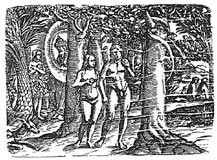
fig. 1 |
became very popular.
In the 16th century, Poznań was identified with
the ancient Stragona, mentioned by Ptolemeus (Sarnicki 1587).
Combined with megalomania such interpretation could have ended
with the grotesque, as in Wojciech Dębołecki's book (published
in Warsaw in 1633), when author tried to prove that the Slavic
(identified with Scythian) were the oldest nation in the world,
while biblical Adam and Eve, in paradise,
|
spoke Polish ( fig. 1).
Also in Germany, the
history of the state had been glorified since 15 th century, yet
its history was derived not so much from the Antiquity but from
the Middle Ages. For instance, a renowned historian of that time,
Heinrich Bebel, put emperors from Otto dynasty much higher in
hierarchy than pagan Greeks and Romans. Johannes Nauclerus who
lived in the 16 th century believed that Providence itself gave
the Germans power over the world, and that the Germanic tribe
was the oldest nation in the world. It was in Germany, in the
beginning of the 16 th century, that fir the first time the issue
of the right to a previously occupied territory was raised. At
that time, the issue pertained to German - French dispute over
Alsatia. A historian of that time, Jacob Wimpfeling claimed that
the French did not have a historically justified right to that
region. A hundred years later a similar question was raised with
regard to the precedence of settlement in Lusatia, where the issue
of co-existence of Slavic and Germanic tribes was discussed. Even
as late as the year 1783, a German historian Karl B. Anton advocated
the primate of Slavs with this respect. Soon enough all this was
to change.
In 18 th century
Poland, in the Enlightenment the ethnogenesis of Poles was a subject
of great interest. The theory of conquest was at that time the
most popular one. Historians looked for the cradle of Slavs in
the east (e.g. in Kolchida or on the Dnieper, the Volga or the
Don) or in the south, in Croatia, Slovakia, Iliria). The ancestors
of Poles were to conquest in the 6 th century AD the
original inhabitants of later Slavic territories. Various theories
concerning ethnogenesis uplifted the readers and were used to
manipulate the citizens at the times of feuds between social classes,
as well as to justify the political system. They were not used,
however, for territorial claims. The Republic of Poland itself
was a multi-ethnical and multi-religious state. The co-existence
of so many nationalities was never a bed of roses, yet conflicts
were not present between minorities but between social classes.
The theory of conquest was used as well (it was generally believed
that the noblemen were Lechistanian and the peasantry were Sarmatian). |
At
the end of the 18 th century, Poland was partitioned by Russia,
Austria and Prussia. If one can believe Józef Kostrzewski, Frederic
the Great, asked for an justification of his occupation of another
country's territory, replied that his historians would somehow
think of the right excuse. The Germans perceived Polish noblemen
proudly dressed in oriental robes, having a different culture
and values, in the same way as the 19 th century Europeans perceived
savage Bushmen ( fig. 2). It was
clear for them that real culture was
the one |
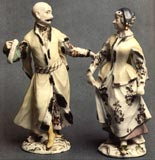
fig. 2 |
of German language and tradition, therefore they expected
a blitz assimilation of their new citizens into German culture.
Only when it was clear to the Germans, that the majority of Polish
people do not even think to "civilize", did they begin to gradually
adjust legal regulations in order to enforce the "civilization"
on the oppressed Polish nation.
Johann Droysen was a
19th century German supporter of the theory of mixing politics
and history. Soon enough he found numerous followers. In the newly
formed science of races, or rather of language groups, the Indo-European
group was shortly defined as the Indo-Germanic one. The name supposed
to be right because in the Middle Ages Germanic tribes influenced
Indo-European civilization so much, that in the areas where their
influence was weaker, until now civilization is not "pure European".
This opinion was popularized, also among some Poles, but later
the terminology was substituted with Aryan terms. The adjective
"Germanic" really meant "German", which was particularly stressed
in the areas where Germany had its territorial interests. |

fig. 3 |
Polish
people were not at all delighted to be ruled by the new government,
which was generally perceived as the oppressors. Many illustrations
of the mentality of that time can be found in the contemporary
newspapers, for example in case of Polish farmer accused of killing
German surveyor. Although he did not deny, the court found him
not guilty, as he explained that he was sure he met the Evil One.
Since on contemporary iconography devil |
was presented in a German dress ( fig.
3), one cannot be punished for killing fiend! In the 19 th,
as the national awareness grew within social circles, it was not
politically correct to give to the Germans Polish national relics
of the past (including archaeological collections). It was not
in good taste to socialize with the oppressors, what in turn brought
about polonization of some German families, especially those living
exclusively among Poles.
Political situation
of those times and the establishment of modern history and archeology
favored the creation of Polish archeological collections, what
was then considered to be a patriotic duty revealing itself by
protecting relics from long gone past. A vast majority of the
19 th century documents, being in possession of Poznań Archaeological
Museum archives, bears traces of this patriotism. Archeological
artefacts, although at that time it was not possible to date them
properly, were collected just for the patriotic reasons. The origins
of nations were examined. As early as in 1857 Wojciech Konewka,
a Polish inhabitant of the island of Ruegen, wrote: "There are
different opinions on the residence of Slavs in this area. Some
say that Slavs were present on these abandoned countries already
in the 5 th century, others believe that Slavs have always been
here." One of the most prominent historians of the 19 th century,
Joachim Lelewel, advocated autochtonism of Slavs and their origin
from (related to Tracks) the Getts and Dacs. He was of an opinion
that such a great nation could not have just arrived from nowhere,
but it had to form in the area, so the ancestors of Slavs must
have settled on the Baltic Sea and the Vistula soon after the
Flood. The tradition of reaching for antique sources and the attempts
to identify Slavs with tribes mentioned by ancient authors was
widespread. The book written by a Slovak historian, P.K. Szafarzyk,
translated into Polish in 1842, was widely respected in Poland.
The author, referring to Jordanes, considered all Weneta tribes,
also the ones living on the Adriatic, with Slavs. He even assumed
that a part of Tracs and Ilirians could have been Salvs as well.
As for the times of Slavic arrival on the banks of Vistula River,
F. Duchiński, a 19 th century historian assumed the year 1000 BC.
There were authors who dated this fact even later in history.
Under the theory of the long-distance ancient trade, numerous
Phoenician factories were considered as "Slavic". Moreover, also
Etruscan, Greek, Roman and other colonies were considered as Slavic.
Shortly before World War One, a Czech researcher, J.L. Pič, opted
for Slavic origins of Lusatian culture, yet he was unable to support
his theory with any evidence. It should be noted here, that already
in 19 th century uneducated villagers called cremation cemeteries
as Aryan, megaliths and grave-mounds as the burials of Huns or
giants and Medieval strongholds as Swedish trenches. All in all,
in the course of the 19th century numerous theories and concepts
on the origin of Slavs and Germanic tribes were created.
Originally, those theories
were not used to justify the rights to land, with maybe one exception
of Pastor Karl Wunster who claimed in 1824, that the traces of
the Germanic tribes in Wielkopolska could be found. Even in 1830,
artefacts from Wielkopolska shown in Berlin were defined as "the
collection of Slavic relics", without the chronological diversification.
Prussian governments tried to use numerous decrees concerning
the protection of the relic of the past in order to create the
collection in Berlin museums. In 1862, a Cracovian art historian,
Józef Łepkowski, complained that "when only a German researcher
finds an ornamented funeral relic in the ground, (...) he immediately
decides of its historical value and unmistakably ascribes
it to Germanic past". Due to
the respect for science |
shared by many,
the 19 th century Polish and German scientists declared
that science was international in its nature and could not be
used as a tool to defend interests of any nation. This cliché
was usually followed by "but" which introduced the denial of the
former manifesto ( fig. 4).
After the successful |
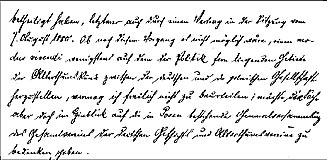
fig. 4 |
war of the Germans against the French in
1870s, the historical awareness was purposely and systematically
used to fight for territory, which brought about the increased
German nationalism. If one may believe the publications of that
time, the PTPN presentation of Wielkopolska relics at the exhibition
in Berlin and Wrocław in 1880s showed that the artefacts of Lusatian
culture were almost identical on both banks of the Odra River.
Soon after that a hypothesis emerged that Germanic settlement,
preceded the Slavic one. Germanic tribes were obviously identical
with the Germans of that times, thus the right of the Germans
to own Wielkopolska were |
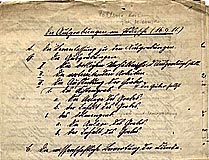
fig. 5 |
undeniable ( fig.
5). It was believed that the general public was not at all
indifferent to the question whether the nation derives from Asia,
or if it is autochthon on the land it owns. Originally a very
simple division was applied - Germanic relics were the ones of
great artistic value, Slavic ones were the primitive and not ornamented
ones. In this way, even Wilhelm Schwartz, a renowned in Wielkopolska
historian of Antiquity, who co-operated
with |
his Polish colleagues, having found in 1879
the graves from the times of Lusatian and Pomeranian cultures
in the vicinity of Poznań described them as Slavic due to "a simple
pottery technique and a lack of ornaments". When it became evident
that it was hard to differentiate archeological material according
to this concept, the Germans developed a new methodology hoping
that maybe minute details would be useful to prove the Germanic
origin of the items. A society called Historische Gesellschaft
f. die Provinz Posen was organized "to present and shed proper
light on the participation of the Germanic culture in the development
of the Poznań region. (
) That would lead to creation of workpiece
deserving the influence exerted by Germanic culture during the
course of all time on the development of the Eastern Margraviate
of the German State" ( fig. 6). Gradually,
a thesis was accepted that the occupation of Wielkopolska by Prussia
was really its return to the mother country and that the new settlers
had all the reasons to feel at home in the occupied land. The
Pomeranian culture was Germanized, while the Lusatian culture
was defined as "Trackian" ( fig. 7) or
"Ilirian". By summoning to collect historical relics, the patriotic
dimension of this activity was strongly stressed. "Historische
Geselschaft" ( fig. 8) reads: "The authorities
strongly support The Museum (...), because of its deeply patriotic
and scientific aims". The conviction of the Germanic supremacy
over the Slavs was fully reflected in the views of Gustav Kossina,
who claimed that" Slavs have always admired bolshevism of some
sort, which was only less severe by impossibility to gather and
by an utter lack of needs. The Germans, who have always, particularly
at the times of wars, been enlivened by the need of law and order,
detested and despised the Slavs." |
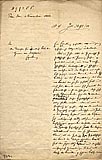
fig. 6 |

fig. 7 |
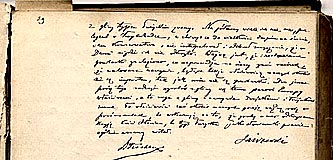
fig. 8 |
Those
views evoked a defensive reaction, which was not always very conscious.
In response to them, Polish historians wrote publications that
pointed to a very high or exceptional level of Slavic or Polish
cultures, which were not always identical. For instance, Wiktor
Czarnecki in his book published in 1900 wrote about the exceptional
role of Poles. In a letter to an unknown person, written in 1910
and attached to a copy of his book, he summarized his views as
follows: "in general, what I have written in "Scythia", is undoubtedly
true. We Poles, are not really Slavs, but belong to a much more
ancient culture, we are the pre-cultural or pre-civilization element
since we have been living in this pre-country of all human legends
for ages. Our language reverberates the echo of pre-civilization
and pre-culture. (...) Our language obviously belongs to the Slavonic
group, but the Slavs were an eastern tribe, which later flooded
us (...). Primarily between the Rhine and man-made embankments
in the east lived German families in the meaning legal since originated
from ritually contracted marriages (...). The people from Germany,
quite unrightfully usurped the name German, as their national
name, for in those distant times there had been no Germanic nation.
Tacit, who includes us within Germania is right, and he only points
at a pernicious influence of anti-cultural, nomadic, steppe Slavs,
flooding in from the east. (...). In Eddean Alwissmal is the key
to European languages which were formed at the time when the Polish
and German state were being established, both countries being
countries of the world, with no borders."
Prof. Jan Sas Zubrzycki,
an architect from Lvov was one of the supporters of Slavic supremacy
over other nations. According to him, the Slavs had used bricks
for constructing their homes even before Christianity was introduced
on the territory, and Slavic art was more valuable than the art
of any other nation. He called Celtic art "pre-Slavic" and he
believed that "Poland emerged from the Slavic nation which occupied
almost all of North-Eastern territory of Europe, even a part
of Italy, France, Spain and England." In 1921 he could still see
the connection between Slavic art with the art of Mykenes, Troy,
and the name of Tracks he derived from "tracze", which in old
Polish meant "carpenters". Germanic Wenedas mentioned by Ptolemy,
according to Zubrzycki, were to be Slavs living on the Rhine,
only this tribe was the first to be denationalized by Teutons.
In many other papers written in the turn of 19 th and
20 th centuries old ideas of Slavic Tracks, Getts and
other antique tribes were mentioned. Thus, as soon as Józef Kostrzewski,
familiar with the ideas of J. Pič and Szafarzyk, and also other
Polish authors, learned in Berlin that G. Kossinna had also claimed
Lusatian culture to be Ilirian and Trackian one, he immediately
combined both approaches, especially that at that time the state-of-the-art
scientific tools which he got to know in Berlin, seemed to enable
the confirmation of this idea. |
In
documents of Poznań Archaeological Museum from the inter-war period
there is no evidence of expansionism in archeology. This historical
period is further discussed in another presentation. The subject
had its very stormy come back in the years 1940 - 1944 when the
museum was in possession of the German Nazi. Pre-history became
a political science, and its sense was very well illustrated on
a poster published at that |
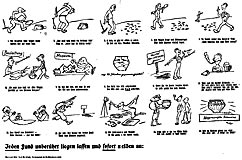
fig. 9 |

fig. 10 |
time ( fig.
9) which encouraged the protection of historical relics. Also
in their private correspondence, German archeologists supported
Hitler's politics of expansion, one exception being Ms. T. Haevernick.
There are letters which show that along with German successful
battles on the frontline, their historians tried to seek in the
East (Caucasus) first only Scythes, then they looked for the elements
of La-Tene culture there, and finally Indo-Germanic or Indo-European
ones which obviously had to originate from Caucasus ( fig.
10). The defeat of Nazi army put an end to this blooming imagination. |
To
sum up, nationalism, megalomania and expansionism in Polish and
German archeology happened, yet their intensity varied depending
on political situation. Most often they were a menace, still in
Poznań we may talk about one positive aspect of this expansionism:
subsequent Polish or German authorities of Poznań Archaeological
Museum did not destroy any documents found by their predecessors,
which was common in other institutions, since all of the source
materials were treated as "our national heritage", even though
the heritage was not definitely mutual. |
Bibliography
(unknown author)
1707 Stragona Abo Stołeczne Miasto Poznań oraz Tabula accuratissima
Tam per totam MaioremPoloniam quam Extra Regnum iak wiele Do Cudzoziemskich
Miast mil rachować się ma Wystawiona w Roku Pańskim 1707,
Poznań
(unknown author)
1839 Zbiór starożytności słowiańskich w Berlinie, Przyjaciel Ludu V/2, pp. 332-335
(unknown author)
1872 Miersuae Chronicon, Monumenta Poloniae Historica II
(unknown author)
1926 Kości Adama i Ewy, Dziennik Poznański z 17 VI 1926, p. 11
Anonim (so called) Gall,
1965 Kronika Polska (transl. R. Grodecki), Wrocław-Warszawa-Kraków
Anton, K. B.
1783 Ueber der Alten Slawen Ursprung, Sitten u.s.w., Lipsk
Dębołęcki, W.
1633 Wywód jedynowłasnego państwa świata, w którym pokazuie
X. Woyciech Dębołecki z Konoiad, Doktor Teologiey S. a. General
Społeczności wyjupywania Więźniów, że nastarodawnieysze w Europie
Królestwo Polskie lubo Schythickie tylko na świecie, ma prawdziwe
Succesory Iedama, Setha, y Iapheta, w Panowaniu Światu od Boga
w Raiu postanowiony, Warszawa
Duchiński, F.
1901 Pisma Franciszka Duchińskiego, vol. I, Rapperswyl, (1st ed. 1858)
Endrulat, B.
1885 Über die Aufgaben der historischen Gesselschaft für die Provinz Posen, Zeitschrift für die Historische Provinzial Gesellschaft, Year I, pp. 5-13
Grabski, A. F.
2003 Dzieje historiografii, Poznań
Lelewel, J.
1853 Narody na ziemiach sławiańskich przed powstaniem Polski. Joachima Lelewela w dziejach narodowych polskich postrzeżenia. Tom do Polski wieków średnich wstępny, Poznań
1859 Dzieje Polski synowcom przez stryja potocznym sposobem opowiedziane, Poznań
Kaczmarek, J.
1996 Organizacja badań i ochrony zabytków archeologicznych w Poznaniu, Poznań
Kadłubek, W.
1974 Mistrza Wincentego Kronika Polska, Warszawa
Kostrzewski, J.
1970 Z mego życia. Pamiętnik. Wrocław-Warszawa-Kraków
Kokowski, A. (ed.)
2002 Cień Światowida, Lublin
Łepkowski, J.
1862 Z przeszłości. Szkice i obrazy. Artykuły felietonowe Józefa Łepkowskiego. Sztuka u Słowian, szczególnie w przedchrześcijańskiej Polsce i Litwie, Kraków
Malinowski, T.
2003 Cierń Światowita, Poznań-Zielona Góra
Neustupny, J., Pič J. L.
1947 Słowiański historyk i czeski prehistoryk, Z otchłani wieków, Year XVI, pp. 89-91
Prusisk, W.
1899 (app.), Scythia biformis, das Urreich der Asen. Eine Skizze aus der polnisch-deutschen Vorgeschichte, Breslau
Sadowski, J. N.
1877 Die Handelsstraßen der Griechen und Römer durch das Flußsgebiet der Oder, Weichsel, des Dniepr und Memel zur Ostsee, Jena
Sas Zubrzycki, J.
1914 Zwięzła historja sztuki, Kraków
Schwartz, W.
1879, Verhandlungen, Zeitschrift für Etnologie, pp. 376
Stryjkowski, M.
1846, Kronika Polska, Litewska, Żmudzka i wszystkiej Rusi
, Warszawa, p. 22 ( 1st ed. 1582)
Szafarzyk, P. J.
1842, Słowiańskie starożytnosci, Poznań
Archiwum Naukowe MAP, nr akt A-dz. 2/1
|
|







